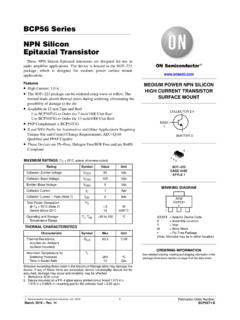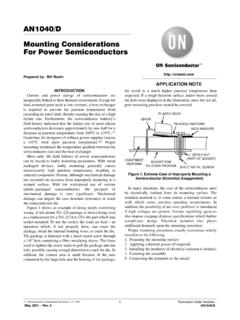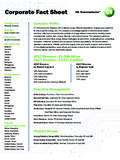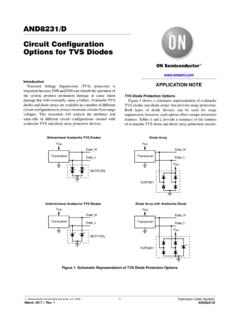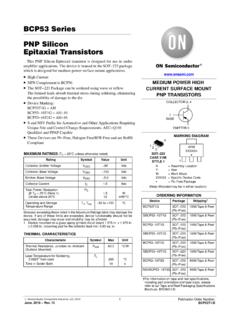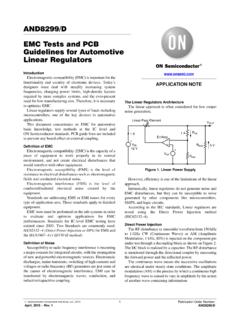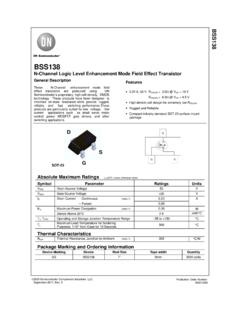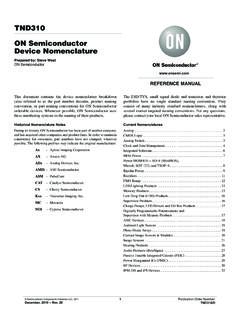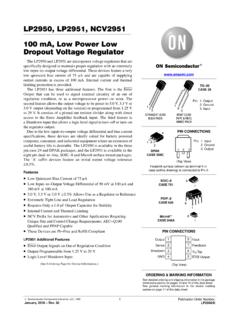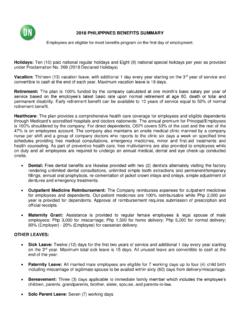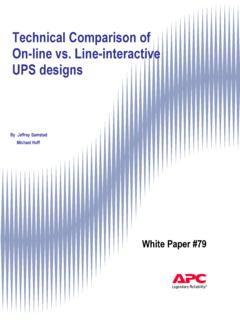Transcription of NCP1010 - Self-Supplied Monolithic Switcher for Low ...
1 Semiconductor Components Industries, LLC, 2014 October, 2016 Rev. 241 Publication Order Number: NCP1010 /DNCP1010, NCP1011,NCP1012, NCP1013,NCP1014 Self-Supplied MonolithicSwitcher for Low Standby-Power Offline SMPSThe NCP101X series integrates a fixed frequency current modecontroller and a 700 V MOSFET. Housed in a PDIP 7 or SOT 223package, the NCP101X offers everything needed to build a rugged andlow cost power supply, including soft start, frequency jittering,short circuit protection, skip cycle, a maximum peak current setpointand a Dynamic self Supply (no need for an auxiliary winding).
2 Unlike other Monolithic solutions, the NCP101X is quiet by nature:during nominal load operation, the part switches at one of the availablefrequencies (65 100 130 kHz). When the current setpoint fallsbelow a given value, the output power demand diminishes, the ICautomatically enters the so called skip cycle mode and providesexcellent efficiency at light loads. Because this occurs at typically 1/4of the maximum peak value, no acoustic noise takes place. As a result,standby power is reduced to the minimum without acoustic circuit detection takes place when the feedback signal fadesaway, in true short circuit conditions or in broken Optocouplercases.
3 External disabling is easily done either simply by pulling thefeedback pin down or latching it to ground through an inexpensiveSCR for complete latched off. Finally soft start and frequencyjittering further ease the designer task to quickly develop low cost androbust offline power improved standby performance, the connection of an auxiliarywinding stops the DSS operation and helps to consume less than100 mW at high line. In this mode, a built in latched overvoltageprotection prevents from lethal voltage runaways in case theOptocoupler would brake.
4 These devices are available in economical8 pin dual in line and 4 pin SOT 223 Built in 700 V MOSFET with Typical RDSon of 11 Wand 22 W Large Creepage Distance Between High Voltage Pins Current Mode Fixed Frequency Operation:65 kHz 100 kHz 130 kHz Skip Cycle Operation at Low Peak Currents Only: No Acoustic Noise! Dynamic self Supply, No Need for an AuxiliaryWinding Internal ms Soft Start Latched Overvoltage Protection with AuxiliaryWinding Operation Frequency Jittering for Better EMI Signature Auto Recovery Internal Output Short CircuitProtection Below 100 mW Standby Power if Auxiliary Windingis Used Internal Temperature Shutdown Direct Optocoupler Connection SPICE Models Available for TRAN sient Analysis These are Pb Free and Halide Free DevicesTypical Applications Low Power AC/DC Adapters for Chargers Auxiliary Power Supplies (USB, Appliances,TVs, etc.)
5 PDIP 7 CASE 626 AAP SUFFIX18 MARKING DIAGRAMSP101xAPyyAWLYYWWG1 See detailed ordering and shipping information in the packagedimensions section on page 21 of this data INFORMATIONSOT 223 CASE 318 EST SUFFIX14 AYW101xyGG14x= Current Limit (0, 1, 2, 3, 4)y= Oscillator FrequencyA (65 kHz), B (100 kHz), C (130 kHz)yy= 06 (65 kHz), 10 (100 kHz), 13 (130 kHz)A= Assembly LocationWL= Wafer LotYY, Y= YearWW, W = Work WeekG or G = Pb Free Package(Note: Microdot may be in either location) , NCP1011, NCP1012, NCP1013, (Top View)PIN CONNECTIONSPDIP 7 SOT 223(Top View)1234 VCCFBDRAINGNDI ndicative Maximum Output Power from NCP1014 RDSon Ip230 Vac100 250 Vac11 W 450 mA DSS14 W11 W 450 mA Auxiliary Winding19 W1.
6 Informative values only, with: Tamb = 50 C, Fswitching = 65 kHz, circuit mounted on minimum copper area as 1. Typical Application Example2734518100 250 Vac++NCP101 XVout+GNDQ uick Selection TableNCP1010 NCP1011 NCP1012 NCP1013 NCP1014 RDSon [W]2211 Ipeak [mA]100250250350450 Freq [kHz]65100130651001306510013065100130651 00 NCP1010 , NCP1011, NCP1012, NCP1013, FUNCTION DESCRIPTIONPin No.(SOT 223)Pin No.(PDIP 7)Pin NameFunctionDescription11 VCCP owers the Internal CircuitryThis pin is connected to an external capacitor of typic-ally 10 mF. The natural ripple superimposed on theVCC participates to the frequency jittering.
7 For im-proved standby performance, an auxiliary VCC can beconnected to Pin 1. The VCC also includes an activeshunt which serves as an opto fail safe protection. 2NC 3 GNDThe IC Ground 24 FBFeedback Signal InputBy connecting an optocoupler to this pin, the peakcurrent setpoint is adjusted accordingly to the outputpower ConnectionThe internal drain MOSFET connection. 7 GNDThe IC Ground 48 GNDThe IC Ground 65, 100 or130 kHzClockOverload?UVLOM anagementGNDNCVCCFBD rainGNDGNDF igure 2. Simplified Internal Circuit Architecture2134 IVCCI?Vclamp*4 V18 kError flag armed?EMI JitteringVCCS tartup SourceDrainFlip FlopDCmax = 65%ResetResetHigh when VCC t 3 VDriverSQR +Iref = mAIVCCSetQVCC8 Rsense250 ++-Soft StartStartup SequenceOverload + VDrain*Vclamp = VCCOFF + 200 mV ( V Typical) NCP1010 , NCP1011, NCP1012, NCP1013, MAXIMUM RATINGS Rating Symbol Value UnitPower Supply Voltage on all pins, except Pin 5 (Drain)
8 VCC to 10 VDrain Voltage to 700 VDrain Current Peak during Transformer SaturationNCP1010/11 NCP1012/13/14 IDS(pk) Current into Pin 1 when Activating the V Active ClampI_VCC15mAThermal CharacteristicsP Suffix, Case 626 AJunction to LeadJunction to Air, oz (70 mm) Printed Circuit Copper Sq. Inch ( Sq. Cm) Sq. Inch ( Sq. Cm)ST Suffix, Plastic Package Case 318 EJunction to LeadJunction to Air, oz (70 mm) Printed Circuit Copper Sq. Inch ( Sq. Cm) Sq. Inch ( Sq. Cm) C/WMaximum Junction TemperatureTJmax150 CStorage Temperature Range 60 to +150 CESD Capability, Human Body Model (All pins except HV) Capability, Machine Model 200 VStresses exceeding those listed in the Maximum Ratings table may damage the device.
9 If any of these limits are exceeded, device functionalityshould not be assumed, damage may occur and reliability may be CHARACTERISTICS (For typical values TJ = 25 C, for min/max values TJ = 40 C to +125 C, Max TJ = 150 C, VCC = V unless otherwise noted.)RatingPinSymbolMinTypMaxUnitSUPPL Y SECTION AND VCC MANAGEMENTVCC Increasing Level at which the Current Source Turns Decreasing Level at which the Current Source Turns between VCCOFF and VCCON1 VVCC Decreasing Level at which the Latch off Phase Decreasing Level at which the Internal Latch is Released1 VCCreset VInternal IC Consumption, MOSFET Switching at 65 kHz (Note 2)1 ICC1 IC Consumption, MOSFET Switching at 100 kHz (Note 2)1 ICC1 IC Consumption, MOSFET Switching at 130 kHz (Note 2)
10 1 ICC1 IC Consumption, Latch off Phase, VCC = V1 ICC2 290 mAActive Zener Voltage Positive Offset to VCCOFF1 Vclamp140200300mVLatch off CurrentNCP1012/13/140 C < TJ < 125 C 40 C < TJ < 125 CNCP1010/110 C < TJ < 125 C 40 C < TJ < 125 SWITCH CIRCUITP ower Switch Circuit On state ResistanceNCP1012/13/14 (Id = 50 mA)TJ = 25 CTJ = 125 CNCP1010/11 (Id = 50 mA)TJ = 25 CTJ = 125 C5 RDSon 1119223816243550W2. See characterization curves for temperature Adjust di/dt to reach Ipeak in See characterization curves for temperature , NCP1011, NCP1012, NCP1013, CHARACTERISTICS (For typical values TJ = 25 C, for min/max values TJ = 40 C to +125 C, Max TJ = 150 C, VCC = V unless otherwise noted.)
